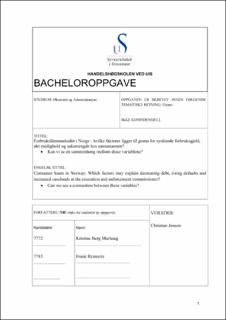| dc.contributor.advisor | Jensen, Christian | |
| dc.contributor.author | Marhaug, Kristine Berg | |
| dc.contributor.author | Reimertz, Frank | |
| dc.date.accessioned | 2021-09-03T16:30:27Z | |
| dc.date.available | 2021-09-03T16:30:27Z | |
| dc.date.issued | 2021 | |
| dc.identifier | no.uis:inspera:80527366:22035902 | |
| dc.identifier.uri | https://hdl.handle.net/11250/2773226 | |
| dc.description.abstract | Sammendrag
Forbrukslånsmarkedet er i stadig endring. Tidligere oppgaver som er skrevet innenfor samme tema har handlet om utviklingen frem til innføringen av gjeldsregistrene. Opptaket av forbrukslån var lenge voksende, med utsikter om at veksten vil avta. Vi har for første gang sett på hvordan markedet har utviklet seg etter gjeldsinformasjonsloven trådte i kraft, og ser en negativ vekst.
Denne oppgaven er basert på nyere data om forbrukslånsmarkedet etter at gjeldsinformasjonsloven trådte i kraft. Samtidig har også markedet blitt påvirket av en global pandemi og endringer i blant annet utlånsforskriften og inkassolovgivningen. Vi tar for oss ulike påvirkningsfaktorer for å se det store bildet og drøfter rundt årsakene til utviklingen, samt belyser positive og negative sider.
Vi ser først på situasjonen i markedet for forbrukslån og hvordan det har endret seg i senere tid. Dette knytter vi opp mot innføringen av gjeldsregisteret, som på flere måter har påvirket til et økende mislighold blant den norske befolkningen. Dette har resultert i økende inntjening hos inkassoselskapene og et enormt trykk på saksmengden hos namsmyndigheten i landet. Som følge av dette har det blitt endringer i inkassoloven.
Videre drøfter vi de ulike påvirkningsfaktorene og effektene disse har hatt. Markedet er sammensatt og vi vil forsøke å trekke frem sammenhenger knyttet til opptak og mislighold. Vi kan blant annet se at det ligger an til å skje en endring blant aldersgruppene som har høyest mislighold, spesielt blant de eldre. Personer over 60 tar opp mer forbrukslån enn tidligere. Blant annet som følge av endret forbruksmønster. Vi legger også frem andre viktige årsaker til nedgangen i forbrukslån og økningen i mislighold og for å drøfte hvordan utviklingen kan antas å fortsette videre fremover.
Avslutningsvis oppsummerer vi den omfattende drøftingen og funnene vi har gjort sett opp mot påvirkningsfaktorer for utviklingen i forbrukslånsmarkedet. Vi kan blant annet se at endringer har vist større utslag enn tidligere antatt, spesielt den negative veksten i forbrukslån. | |
| dc.description.abstract | Summary
The consumer loan market is constantly changing. Previous assignments written within the same topic have dealt with developments up to the introduction of debt registers. The raising of consumer loans was growing for a long time, with prospects that growth will slow down. We have for the first time looked at how the market has developed after the Debt Information Act came into force, and we see a negative growth.
This task is based on recent data on the consumer loan market after the Debt Information Act came into force. At the same time, the market has also been affected by a global pandemic and changes in, among other things, the lending regulations and debt collection legislation. We consider various influencing factors to see the big picture and discuss the reasons for the development, as well as highlight positive and negative aspects.
We first look at the situation in the consumer loan market and how it has changed in recent times. We link this to the introduction of the debt register, which in several ways has influenced an increasing default among the Norwegian population. This has resulted in increasing earnings at the debt collection companies and an enormous pressure on the case volume at the registration authority in the country. As a result, there have been changes in the Debt Collection Act.
Furthermore, we discuss the various influencing factors and the effects these have had. The market is complex, and we will try to highlight connections related to admissions and defaults. Among other things, we can see that there is likely to be a change among the age groups with the highest defaults, especially among the elderly. People over 60 take out more consumer loans than before. Among other things as a result of a changed consumption pattern. We also present other important reasons for the decline in consumer loans and the increase in defaults and to discuss how the development can be assumed to continue further in the future.
In conclusion, we summarize the extensive discussion and findings we have made against influencing factors for developments in the consumer loan market. Among other things, we can see that changes have had a greater impact than previously assumed, especially the negative growth in consumer loans. | |
| dc.language | nob | |
| dc.publisher | uis | |
| dc.title | Forbrukslånsmarkedet i Norge - hvilke faktorer ligger til grunn for synkende forbruksgjeld, økt mislighold og saksmengde hos namsmannen?
Kan vi se en sammenheng mellom disse variablene? | |
| dc.type | Bachelor thesis | |
